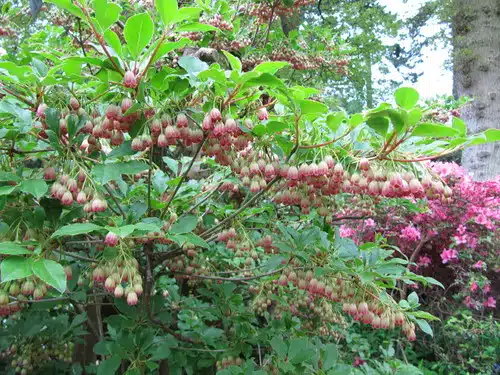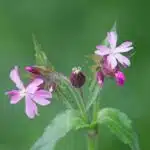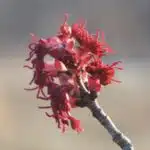Enkianthus is a genus of shrubs that belongs to the Ericaceae family. They are native to East Asia and North America, and they are well-known for their beautiful flowers and foliage. Among the Enkianthus species, the Red Vein Enkianthus (Enkianthus campanulatus) stands out due to its striking red veins that contrast with its green leaves. This plant is a great addition to any garden or landscape, and its cultivation can be very rewarding.
In this article, we will provide you with a comprehensive guide on how to grow Red Vein Enkianthus successfully. We will cover all the aspects of its cultivation, from soil preparation and planting techniques to watering, fertilization, and pruning. Our aim is to help you create a healthy and vibrant Red Vein Enkianthus shrub that will thrive in your garden or landscape for many years to come. Whether you are an experienced gardener or a beginner, this guide will provide you with valuable insights into the art of growing one of the most beautiful Enkianthus species.
Overview Of The Red Vein Enkianthus
Red Vein Enkianthus is a stunning ornamental plant that belongs to the heath family. It is a deciduous shrub that can grow up to 10 feet tall and wide, with an upright habit and a bushy appearance. The most striking feature of this plant is its reddish-purple veins that run along the edges of its leaves, which provide a magnificent contrast against its green foliage.
This plant prefers cool climates and thrives in moist, well-draining soils with slightly acidic pH levels. It can tolerate full sun but performs best in partially shaded areas, where it receives filtered sunlight for at least four hours a day. Red Vein Enkianthus is hardy in USDA zones 5 to 8, making it an ideal choice for gardeners living in these areas.
To ensure optimal growth and blooming, it is crucial to provide your Red Vein Enkianthus with the right growing conditions. In the next section, we will discuss how to choose the right location for your plant depending on various factors such as soil type, light exposure, and temperature requirements.
Choosing The Right Location For Your Plant
Red vein enkianthus plants require proper sun exposure and soil acidity level to grow effectively. It is important to choose a location that receives partial shade and has well-drained soil with pH between 5.0 and 6.5. Avoid planting in areas that receive direct sunlight for prolonged periods, as this can lead to leaf scorching and poor growth.
For best results, look for sheltered areas where the plant is protected from strong winds and harsh weather conditions. This can help prevent damage to the leaves and ensure healthy growth throughout the year. Additionally, consider the drainage considerations of your chosen location. Red vein enkianthus plants prefer moist, well-draining soils but do not tolerate waterlogged or poorly drained soils.
When selecting a location for your red vein enkianthus plant, it’s important to keep in mind that soil preparation plays a crucial role in the success of your plant’s growth. The subsequent section will cover the necessary steps required to prepare your soil for optimal growth of red vein enkianthus plants. By taking these factors into consideration when choosing a location for your plant, you can help ensure healthy growth and flowering season after season.
Soil Preparation And Requirements
Soil is the foundation of any plant’s growth and development. To ensure your red vein enkianthus grows well, it is important to prepare the soil adequately. The first step in soil preparation is to choose a location that receives sufficient sunlight and has good drainage. The ideal pH level for growing red vein enkianthus is between 4.5-6.0, which means the soil should be acidic.
Composting benefits the soil by providing essential nutrients that are required for plant growth. Incorporating compost into the soil before planting will enrich it with organic matter and improve its texture, allowing better water retention and drainage. To make compost, use kitchen waste such as vegetable scraps, eggshells, coffee grounds or yard waste such as leaves and grass clippings. Mix these materials together in a compost bin or heap and allow them to decompose over time.
Mulching techniques help retain moisture in the soil while also suppressing weeds that can compete with your red vein enkianthus for nutrients and water. Mulching involves covering the top layer of soil around the plant with organic material such as wood chips or straw. This helps keep the roots cool during hot weather and warm during colder temperatures while also preventing erosion caused by heavy rainfall. It is recommended to apply mulch around your red vein enkianthus at least once a year to maintain optimal health and growth.
Having prepared your soil using composting benefits and mulching techniques, it is now time to move on to planting techniques and tips. These will ensure that you give your red vein enkianthus the best start possible towards healthy growth and development.
Planting Techniques And Tips
The success of growing red vein enkianthus lies in the right planting techniques and tips. Think of it like cooking a delicious meal; you need to follow the recipe correctly, or else the outcome might not be what you expected. Planting is not just digging a hole and putting the plant in; it requires precision, care, and attention to detail.
Container gardening is an excellent option for people with limited space or those who want to grow plants indoors. Red vein enkianthus can thrive in containers as long as you provide them with adequate drainage holes, soil, and nutrients. Companion planting is another technique that works well with red vein enkianthus. Pairing it with other plants that share similar needs will create a harmonious ecosystem where each plant benefits from the other.
As a horticulturalist or plant expert, I can confidently say that planting techniques and tips are essential for growing red vein enkianthus successfully. Container gardening and companion planting are two effective methods that will help you achieve this. In the next section, we will discuss watering and irrigation best practices that will further aid in ensuring your plants’ growth and health.
Watering And Irrigation Best Practices
Watering and irrigation are crucial aspects of cultivating healthy red vein enkianthus plants. The frequency of watering will depend on the climate, soil type, and drainage capacity of the planting area. In general, it is recommended to water deeply but infrequently to promote deep root growth.
Drip irrigation systems are an efficient way to water red vein enkianthus plants as they deliver water directly to the root zone while minimizing evaporation and runoff. These systems can be set up with a timer to ensure consistent watering frequency without overwatering. It is important to regularly check drip emitters for clogs or damage and adjust the system as necessary.
To determine when it is time to water red vein enkianthus plants, it is helpful to monitor soil moisture levels by sticking a finger into the soil up to the second knuckle. If the soil feels dry at this depth, it is time to water. Avoid watering when the soil is still moist as this can lead to root rot and other diseases.
- Water in the morning or evening when temperatures are cooler
- Apply mulch around the base of plants to retain moisture and regulate soil temperature
- Allow excess water to drain away from plant roots
Moving on from proper watering practices, fertilization and nutrient management play a crucial role in maintaining healthy red vein enkianthus plants.
Fertilization And Nutrient Management
Watering and irrigation are essential for the growth of red vein enkianthus, but it is not enough to ensure their optimal health. Fertilization and nutrient management are also crucial aspects that should not be overlooked. Properly managed fertilization can provide the necessary nutrients that these plants need to grow vigorously and produce healthy blooms.
Organic fertilizers are an excellent option for red vein enkianthus as they release nutrients slowly over time, ensuring a steady supply of nutrients for the plants. Compost tea is another popular organic fertilizer that is easy to make at home by steeping compost in water. This liquid fertilizer provides a balanced mix of nutrients and beneficial microorganisms that can promote soil health, enhance root development, and support plant growth.
It is important to note that over-fertilization can harm your red vein enkianthus, so it is best to follow recommended guidelines or consult with a horticulturist or plant expert. Additionally, regular soil testing can help identify nutrient deficiencies or imbalances and inform decisions on appropriate fertilization practices. By providing adequate nutrition through proper fertilization, you can ensure your red vein enkianthus will thrive and produce beautiful blooms year after year.
As we have discussed earlier, proper pruning and maintenance are critical components of growing healthy red vein enkianthus plants. In the next section, we will delve into the best practices for pruning these plants to encourage better branching structure, promote flowering, maintain plant size, and improve overall health.
Pruning And Maintenance
An example of the importance of pruning and maintenance can be seen in a red vein enkianthus that was left to grow without intervention. The plant became overgrown and developed weak branches that were unable to support its weight, resulting in a lopsided appearance. Pruning techniques can help prevent this by removing dead, diseased, or damaged wood as well as shaping the plant to promote healthy growth patterns.
When it comes to pruning red vein enkianthus, timing is crucial. It’s best to prune immediately after flowering has finished in late spring or early summer. This will allow for new growth during the growing season and ensure that the plant has a chance to recover before winter sets in. Pruning should be done selectively, focusing on removing any dead or damaged wood and thinning out crowded areas.
In addition to regular pruning, maintenance tasks like fertilizing and watering are also important for promoting healthy growth patterns in red vein enkianthus. Fertilizer should be applied in early spring before new growth begins, and again in mid-summer if necessary. Watering should be done deeply but infrequently, allowing the soil to dry out slightly between waterings. By following these guidelines for pruning and maintenance, gardeners can ensure that their red vein enkianthus plants remain healthy and attractive year after year.
To maintain a thriving red vein enkianthus plant, it’s important to keep an eye out for common pests and diseases that can harm it. Some of the most common problems include spider mites, scale insects, powdery mildew, and root rot. Regular inspection of the leaves and stems can help catch these issues early so they can be addressed promptly with appropriate treatments such as insecticides or fungicides. By staying vigilant about pest and disease control along with proper pruning techniques and maintenance practices, gardeners can enjoy the beauty of their red vein enkianthus plants for years to come.
Common Pests And Diseases To Watch Out For
Pruning and maintenance are essential practices to ensure the healthy growth of red vein enkianthus. However, even with proper care, these plants can still be susceptible to pests and diseases. Therefore, it is imperative to take preventive measures to avoid infestations and infections.
One of the most common pests that attack red vein enkianthus is spider mites. These tiny arachnids suck the sap from the leaves, causing discoloration and distortion. To prevent them from infesting your plant, keep the air around your enkianthus humid by misting or placing a tray with water nearby. Additionally, you can use insecticidal soap or neem oil as treatment options if you notice an infestation.
Another disease that affects red vein enkianthus is leaf spot. This bacterial infection causes yellow or brown spots on the leaves and may lead to defoliation if left untreated. Prevention measures include avoiding overhead watering and removing infected leaves immediately. As for treatment options, copper-based fungicides are effective in controlling leaf spot.
Now that we have discussed how to prevent and treat pests and diseases in red vein enkianthus let us move on to propagation methods for this plant species.
Propagation Methods For Red Vein Enkianthus
Did you know that red vein enkianthus is a slow-growing plant that can take up to three years to reach maturity? This may seem like a long time, but with the right propagation methods, you can enjoy the beauty of this plant in your garden for years to come. Here are two effective propagation techniques for growing red vein enkianthus:
- Air layering technique: This is a popular method of propagating red vein enkianthus as it allows the plant to grow roots while still attached to its parent plant. To do this, select a healthy branch and make a small cut on the bottom side. Apply rooting hormone and wrap moist sphagnum moss around the cut area before covering it with plastic wrap. After roots have formed, cut the branch below the rooted area and transplant it into soil.
- Seed germination: Red vein enkianthus seeds are relatively easy to germinate but require patience as they can take several months to sprout. Start by soaking the seeds in water for 24 hours before planting them in well-draining soil mixed with peat moss. Keep them moist and warm (around 70°F) until they sprout.
As a horticulturalist or plant expert, I highly recommend using these propagation methods to successfully grow red vein enkianthus. With air layering and seed germination, you can produce new plants that are genetically identical to their parent while also ensuring their health and vitality.
Now that you understand how to propagate red vein enkianthus, let’s move on to answering some frequently asked questions about growing this beautiful plant.
Frequently Asked Questions About Growing Red Vein Enkianthus
Growing Red Vein Enkianthus can be an exciting and fulfilling experience for horticulturists and plant enthusiasts. However, it is not without its challenges. Some frequently asked questions about growing this plant include what type of soil and watering requirements are needed, whether it can be grown in containers, and what companion plants are best suited to grow alongside it.
Regarding soil requirements, Red Vein Enkianthus thrives in well-draining acidic soils that are rich in organic matter. It is important to avoid alkaline soils as they can cause leaf yellowing and stunted growth. Additionally, the plant requires consistent moisture but not waterlogging. Adequate drainage is crucial to prevent rotting of the roots.
Container gardening is also a viable option for growing Red Vein Enkianthus. A container with adequate drainage holes should be used with a high-quality potting mix that is specifically formulated for acid-loving plants. The container should also be placed in a location that receives partial shade to prevent the plant from drying out too quickly or getting scorched by direct sunlight.
When selecting companion plants for Red Vein Enkianthus, it is crucial to choose plants that share similar environmental requirements such as soil acidity and moisture levels. Some great options could include heather, azaleas, rhododendrons, or other acid-loving shrubs or perennials. Companion planting can also help improve overall garden health by attracting beneficial insects and deterring pests while adding aesthetic value to the landscape.
Conclusion
The Red Vein Enkianthus is a beautiful and unique plant that can add a pop of color to any garden or landscape. Growing this plant requires proper location selection, soil preparation, planting techniques, watering and irrigation practices, pruning and maintenance, and pest and disease prevention methods.
When choosing the right location for your Red Vein Enkianthus, it is important to consider factors such as sun exposure, soil type and drainage, and proximity to other plants. Soil preparation should involve adding organic matter to improve nutrient availability and drainage.
Planting techniques should take into account the depth of the hole and the spacing between plants. Watering practices should be consistent but not excessive in order to prevent root rot. Pruning can help shape the plant and promote healthy growth.
Common pests and diseases include spider mites, scale insects, leaf spot fungus, and powdery mildew. Propagation methods include taking cuttings or layering.
In conclusion, growing Red Vein Enkianthus requires attention to detail in several areas but can result in a stunning addition to any garden or landscape. As horticulturalists, we must continue to educate ourselves on best practices for growing this unique plant and share our knowledge with others who share our passion for gardening. So why not give it a try? Who knows what beauty you could create in your own backyard?
Image Credits
- “Enkianthus campanulatus (Red Vein Enkianthus)” by wallygrom (featured)





























